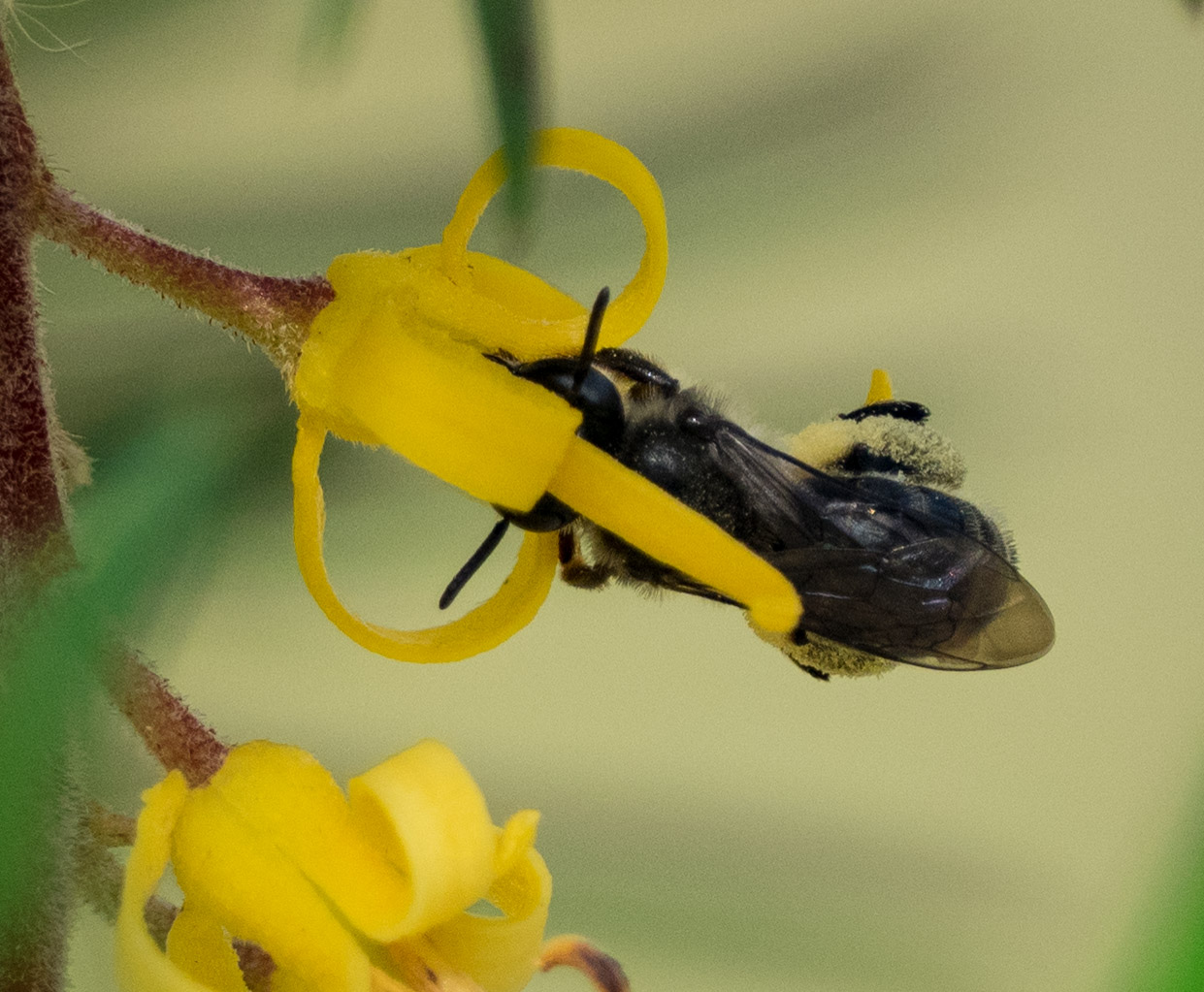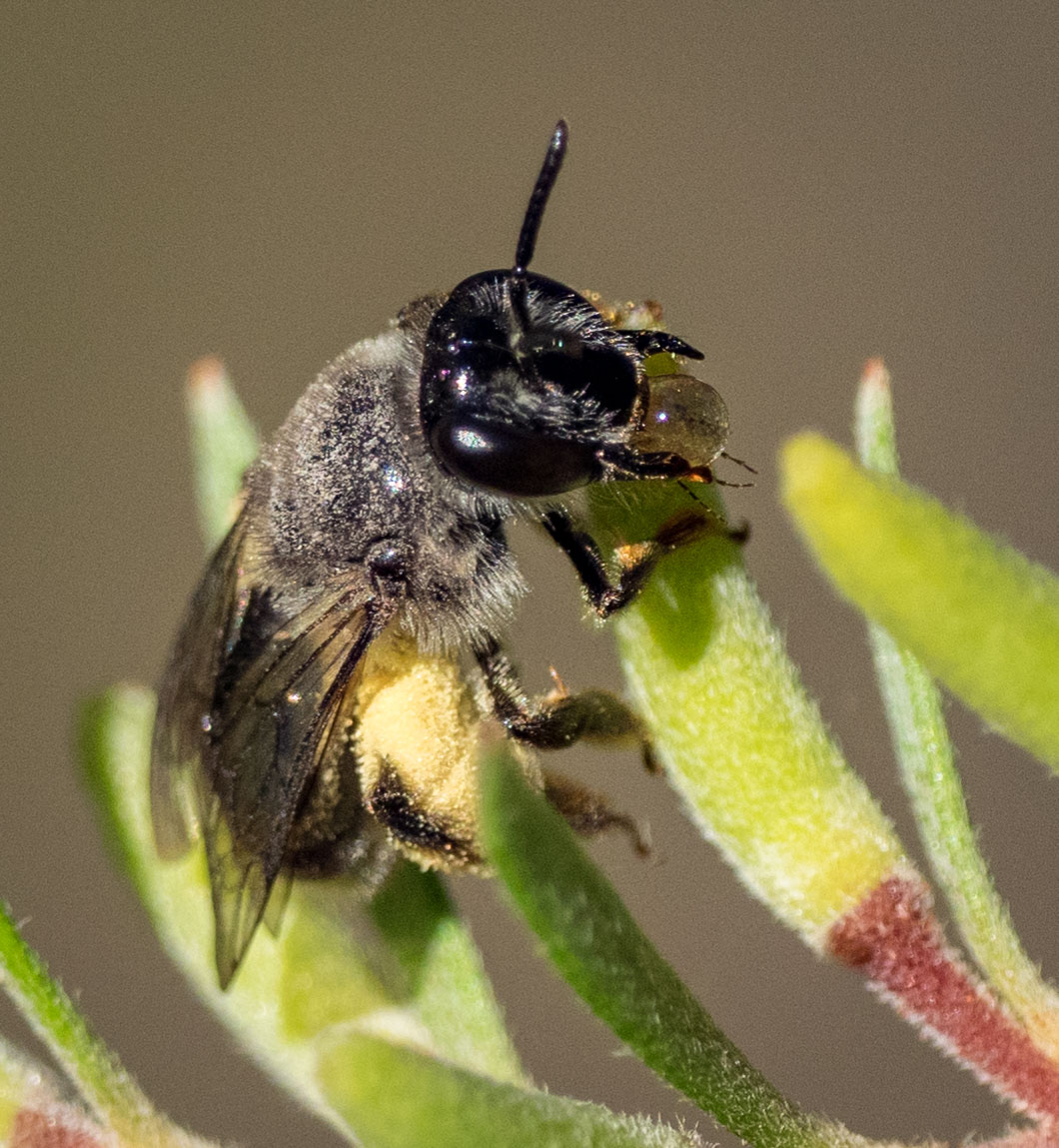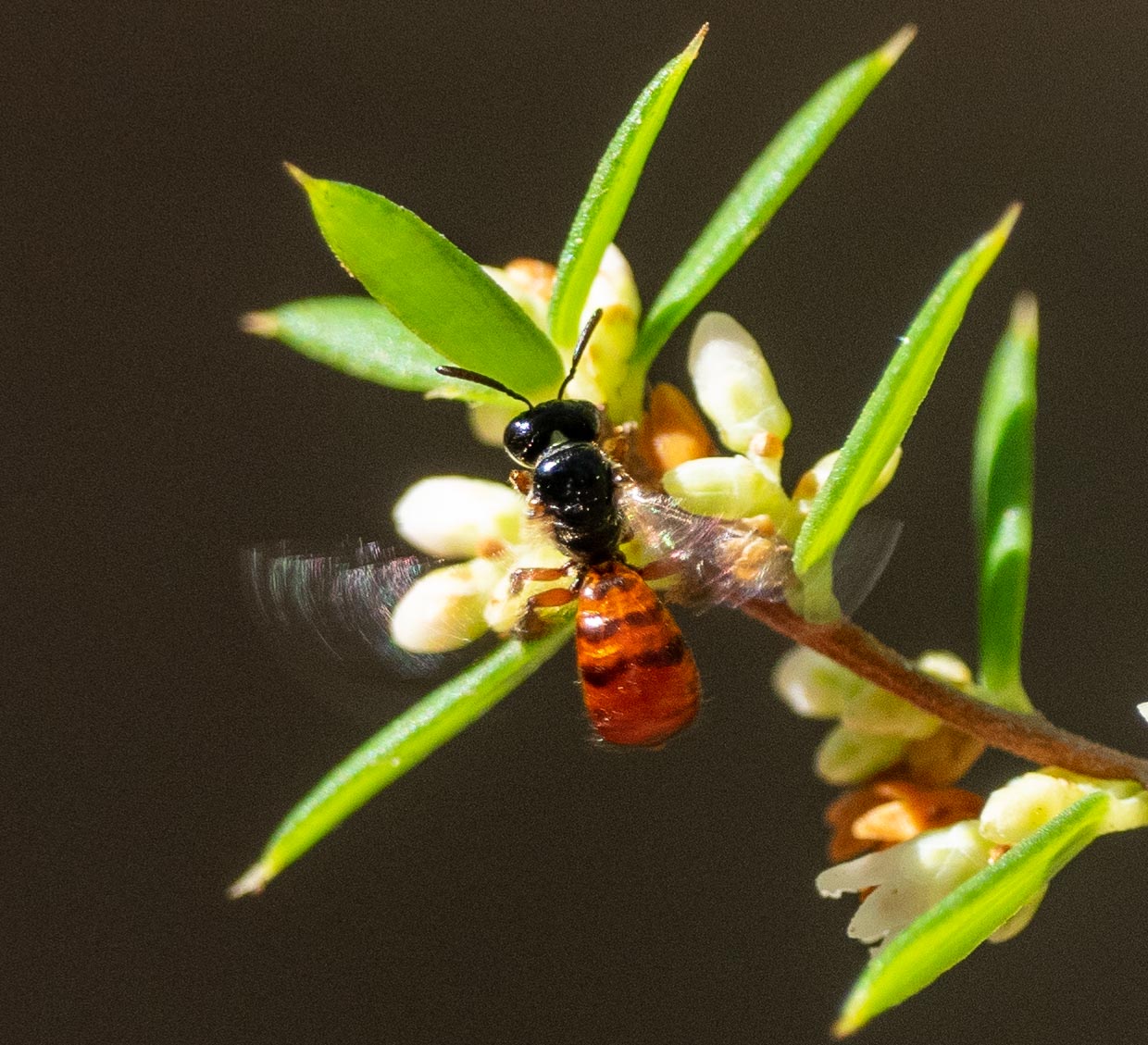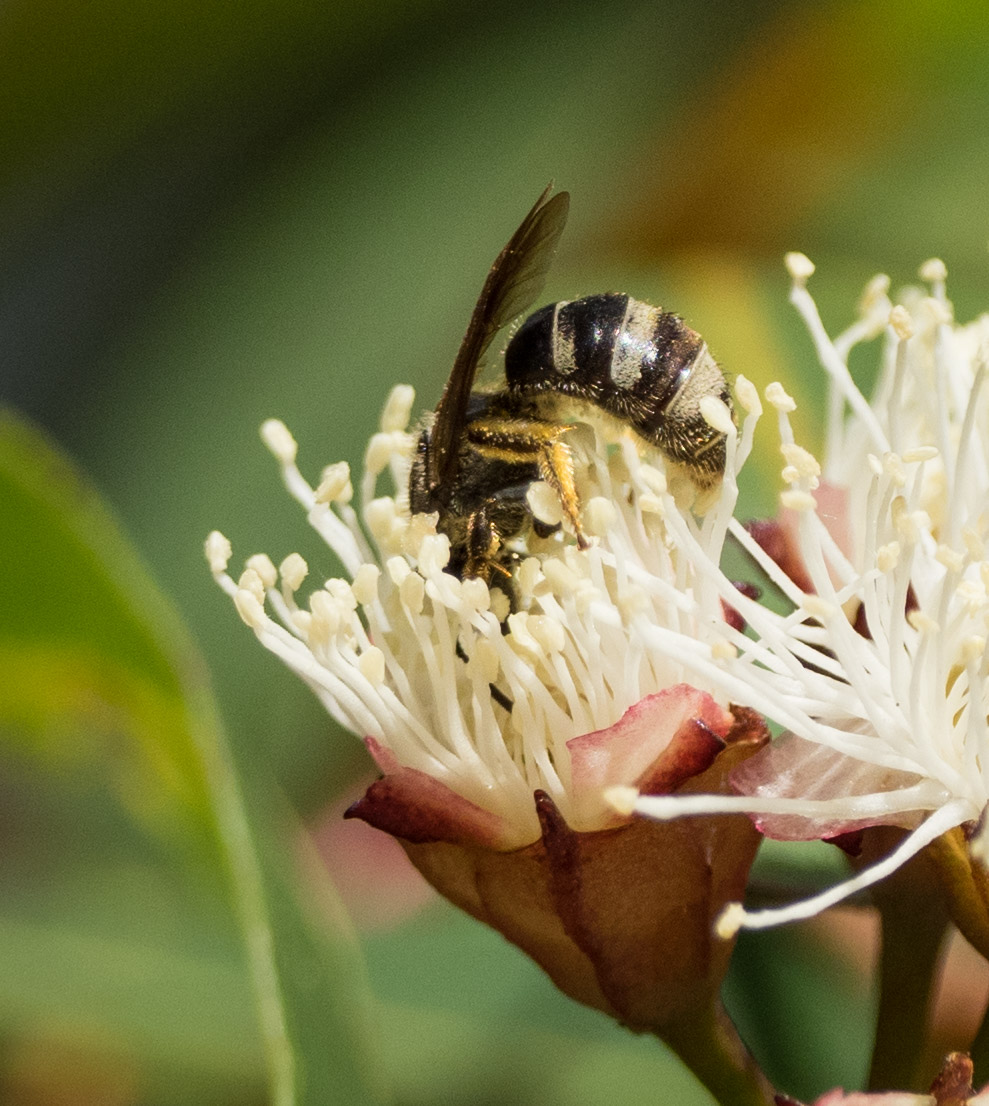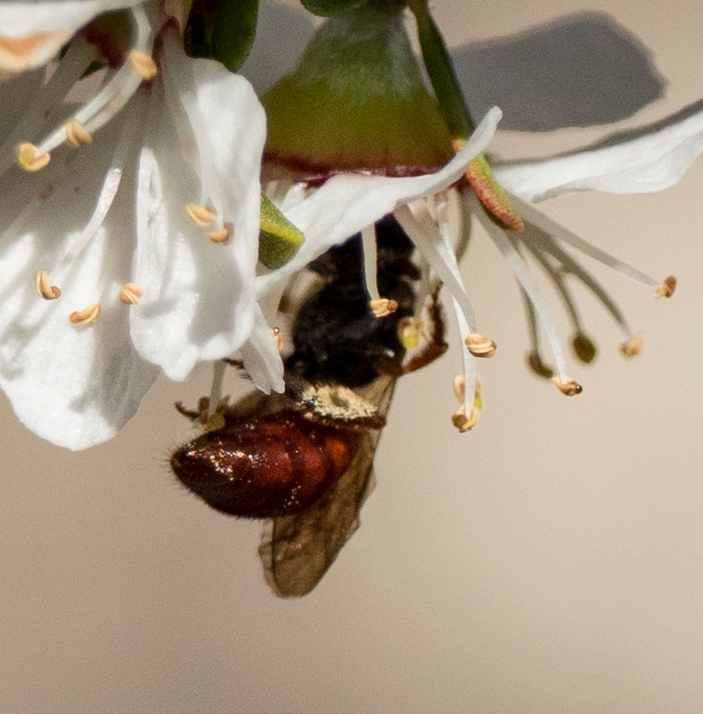Geebung and a native bee
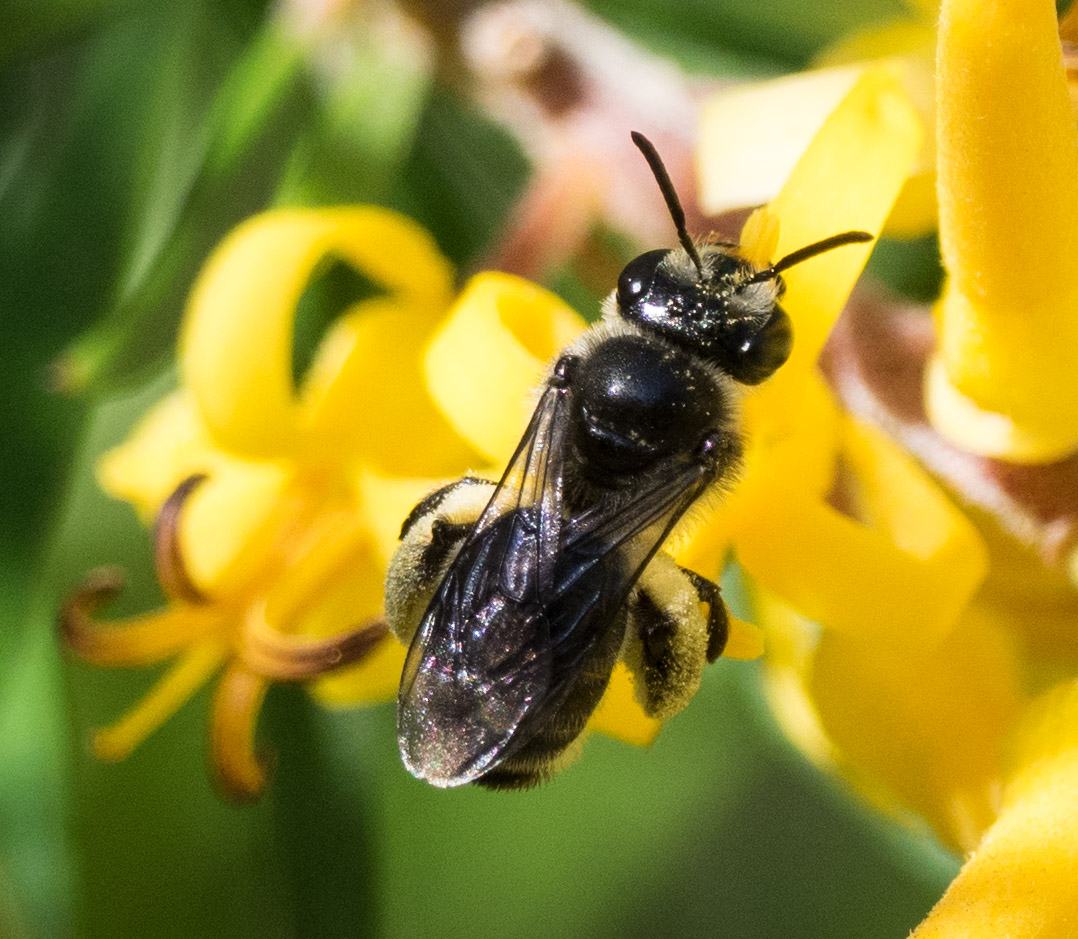
Rather few of our forest plants flower in January, but this is the peak month for Geebung (Persoonia spp.). Our most common Geebung is Persoonia linearis, the Narrow-leaved Geebung. It is a beautiful shrub, with bright yellow flowers, intensely green leaves, and an unusual papery red bark.
And I've been taking a close look at the insects that visit the flowers – with a particular focus on the bees (of course!)
One of the first things I noticed was that the bush is not teeming with insects. Unlike the Leptospermum and Leucopogon flowers I've studied previously, I have to wait patiently to see any insects at all.
And they are nearly always the same species of bee .... a medium-sized, rather hairy bee with a distinctive way of moving over the flowers.
So, with photos in hand, I set out to learn more ...
What type of bee is this?
Ideally, of course, I'd like to identify it to species level, but failing that I'll settle for genus or even family. I went back to the summary I put together a couple of months ago (see my October 12 post, Getting to know bees), feeling quite optimistic. The photos clearly show some of the important characters in bee identification: where the pollen is carried, the wing venation, and the length of the tongue ... I kid you not!
Step 1: It's definitely a bee. Bees and wasps can look very, very similar. However, only bees collect and transport pollen to feed their young. This species is certainly collecting pollen!
Step 1: It must be a bee, as wasps don't gather and carry pollen. The tricky thing with bees, however, is that not ALL bees carry pollen ON their bodies ... many species swallow it and so carry it hidden away INSIDE their bodies ... and they really do look like wasps! Luckily, this is not one of those bees.
Step 2: It's almost certainly a Colletid bee. Of the four main families of bees, only two have short tongues - Colletidae (of which Australia has 871 species!) and Halictidae (another 384 species). I ruled out the latter as although their tongues are short, they can project them on an extendable base ... in none of my photos (and I've taken rather a lot!) do I see the bee projecting its tongue any distance at all. [Note the caveat "almost certainly a Colletid" ... that's because there is a small, fifth family of short-tongued bees (Stenotrididae) - but I decided to try to first get a match among the more common Colletidae family.]
Step 2: Bees in the large family Colletidae have short, blunt tongues.
Step 3: I can rule out two major sub-families of Colletids. Remember those bees I mentioned that carry pollen internally, NOT using specialised pollen-carrying hairs on their bodies? Well, they are all Colletids too ... so my 'geebung bees' are clearly not in those groups. That is, they are neither Euryglossinae nor Hylaeinae bees.
Step 4: That makes the genus Leioproctus a strong candidate! Although at this step in the process of elimination, I couldn't be sure, Leioproctus is a common genus (with many species), and so I decided to test my bees against the two other important characters in bee ID ... where the pollen is carried, and the wing venation.
Step 5: Pollen-carrying is a match. Leioproctus carry pollen on their hind legs, and primarily on their tibia. So do the geebung bees!
Step 5: The longest and thickest of the pollen-carrying hairs are on the tibia. The tibia is the part of the leg below the bee's 'knee'. The femur (above the 'knee') is also used to carry pollen, but not so much.
Step 6: Wing venation is a match for Colletidae - and for Leioproctus, in particular! I used the venation diagrams in Ken Walker's very helpful guide (Bowerbird Bugle, Edition 41).
Step 6: The venation of the forewing is typical of the family Colletidae, and quite different to that seen in Halictidae.
What is known about the pollination of Persoonia?
One of the main reasons Paul and I seek to identify the species we see is so that we can learn more about how they interact in the forest environment. Our own observations provide valuable insights, but we also draw heavily upon published research. And when I searched 'Persoonia' and 'pollination' I struck gold! A 1996 paper describes a detailed study of the pollination ecology of Persoonia in New South Wales - perfect! The full reference is provided at the bottom of this post.
1: Leioproctus is a major pollinator of Persoonia. The study found that among the many different insects that forage on Persoonia, Leioproctus dominates in terms of numbers. Both male and female bees take nectar from flowers, and both carry pollen that can be readily transferred to other Persoonia flowers they visit.
2: The shape of Persoonia flowers excludes smaller, short-tongued bees. For an insect to be an effective plant pollinator, the insect must carry pollen from the anthers of one flower to the stigma of another flower of the same species. Seems obvious, right? Well, many plant-foraging insects take nectar or pollen and yet fail to serve as pollinators for the plant. For example, they may be too small to contact the stigma or they may sip at the nectar without touching the pollen. Or, as is the case with Reed Bees (Exoneura spp.), they may visit such a wide range of flower species that the pollen is simply lost in transit.
Persoonia narrows the field in terms of which insects can access its nectar reward. The floral parts appear to form a tube, but the pieces are not fused. With enough strength and body length, an insect can prise apart the tepals and so access the nectar. Even a short-tongued bee like Leioproctus!
Pressuring the tepals apart to access the nectar
3: Leioproctus show a specialised feeding behaviour ... "it is known". Photographing small things really does force you to look closely. In order to predict where an insect will land - and therefore where and when I might get a shot - I usually spend a while observing how they move and what they are doing. Conversely, once I have the photos, I can look for patterns of behaviour I might have missed in real time.
Leioproctus is a case in point: I had noticed a highly stereotyped behaviour as each bee visited a flower. Standing atop the anther tips, with her underside in contact with the stigma, she would use her front legs to gather pollen. This involved bracing the tip of the anther with her mouthparts while she scraped her front legs down the anther, and then back to her body. After transferring the pollen to her other legs, she would then turn to another anther on the same flower and give it the same treatment.
1: push
2: reach
3: pull
4: turn
And it turns out that the specialised behaviour Leioproctus has evolved when feeding on Persoonia has been reported in earlier studies ... I wasn't imagining it after all!
I say 'she' here as it is only the females that actively gather pollen. The male bees also visit Persoonia, but for nectar only. Any pollen they collect is accidental and they lack specialised pollen-carrying hairs.
And, like many liquid-feeding insects, bees 'bubble'
If you see a bee stop feeding and simply resting on the plant, it is worth taking a closer look - they are likely to be blowing bubbles. They apparently do this to concentrate and process their last feed of nectar. Quite amazing to witness.
Reference
Bernhardt, P. & Weston, P.H. (1996). The pollination ecology of Persoonia (Proteaceae) in eastern Australia. Telopea: Journal of Plant Systematics, 6(4), 775-804.









